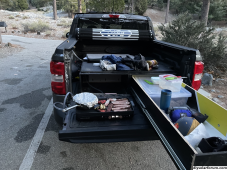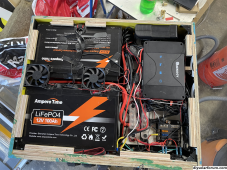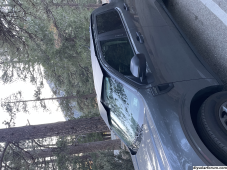CamperMaverick
New Member
Hi all,
I built my first power station for a camper platform for my Ford Maverick. I'm having performance issues. I'll explain the issue, share the specs, the things I know I need to fix anyway (but I don't think are causing the issue). Would love your feedback, and anything else you notice as well.
The issue: battery drains much faster than expected. I have a load that, when maxed out, pulls 1800 watts. But even well before maxing it out (pulling around 900 watts), it's crushing the battery. For example, the battery was at 13.0 volts, which is 30% according to LiTime manual. Running the load at 900 watts for about three minutes brought the battery to 11.5 volt, which according to the manual is approximately 4%. Given the battery's capacity (2560 watts), my understanding is that it should have around 768 watts left. And a load of 900 watts for three minutes should really only drain around 45 watts. Granted it's an inductive load, but should it really crush the battery that much? It'll recover a bit afterwards, but is still drained substantially. I'm mostly monitoring it using Renogy's DC Home app and the BT-2 module. "Beeps" from the system indicate the struggle is real.
Specs:
Two 12 volt 100ah LiTime batteries, wired in parallel with two 4 gauge wires (didn't have the room for 1/0 so tried doubling up as it's also what Renogy does with Inverter)
2000 watt Renogy Inverter
50 amp Renogy DC-DC On Board Battery Charger with MPPT
15 amp AC charger
12 volt, 100 ah fuse block
Everything was bought from OfferUp, which certainly could cause it. Batteries were new in-box though. Tested everything else, except AC charger, which has been working fine.
Known issues/planned improvements:
I built my first power station for a camper platform for my Ford Maverick. I'm having performance issues. I'll explain the issue, share the specs, the things I know I need to fix anyway (but I don't think are causing the issue). Would love your feedback, and anything else you notice as well.
The issue: battery drains much faster than expected. I have a load that, when maxed out, pulls 1800 watts. But even well before maxing it out (pulling around 900 watts), it's crushing the battery. For example, the battery was at 13.0 volts, which is 30% according to LiTime manual. Running the load at 900 watts for about three minutes brought the battery to 11.5 volt, which according to the manual is approximately 4%. Given the battery's capacity (2560 watts), my understanding is that it should have around 768 watts left. And a load of 900 watts for three minutes should really only drain around 45 watts. Granted it's an inductive load, but should it really crush the battery that much? It'll recover a bit afterwards, but is still drained substantially. I'm mostly monitoring it using Renogy's DC Home app and the BT-2 module. "Beeps" from the system indicate the struggle is real.
Specs:
Two 12 volt 100ah LiTime batteries, wired in parallel with two 4 gauge wires (didn't have the room for 1/0 so tried doubling up as it's also what Renogy does with Inverter)
2000 watt Renogy Inverter
50 amp Renogy DC-DC On Board Battery Charger with MPPT
15 amp AC charger
12 volt, 100 ah fuse block
Everything was bought from OfferUp, which certainly could cause it. Batteries were new in-box though. Tested everything else, except AC charger, which has been working fine.
Known issues/planned improvements:
- Batteries are wired with two 4 gauge wires between positive posts, and negative posts, respectively. Only one four gauge wire from batteries to bus bar, and bus bar to inverter. Need to add wire from battery to bus bar, and bus bar to inverter
- Add fuses!
- Route out space below heat sink of DC-DC charger to allow more space
- Clean up wiring
- Plugs for fans when not in use
- Need to add fuse box cover






